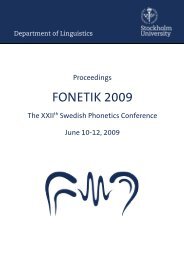The Double Passive in Swedish - Institutionen för lingvistik ...
The Double Passive in Swedish - Institutionen för lingvistik ...
The Double Passive in Swedish - Institutionen för lingvistik ...
Create successful ePaper yourself
Turn your PDF publications into a flip-book with our unique Google optimized e-Paper software.
<strong>The</strong> rule <strong>in</strong> (11) changes the subcategorised grammatical functions of the verb ‘eat’, and “rel<strong>in</strong>ks” the<br />
semantic roles <strong>in</strong> the a-structure, as shown <strong>in</strong> (12) (cf. Kroeger, 2008:62).<br />
(12) ate b) eaten <br />
SUBJ OBJ OBL SUBJ<br />
As shown <strong>in</strong> (12), the argument structure <strong>in</strong> LFG represents the number and type of arguments<br />
associated with a particular predicate.<br />
2.4 Constituents of the <strong>Double</strong> <strong>Passive</strong><br />
Now, a description of constituents of a <strong>Double</strong> <strong>Passive</strong> construction will be shown accord<strong>in</strong>g to the<br />
literature.<br />
2.4.1 Inf<strong>in</strong>itival complements and PRO<br />
An <strong>in</strong>f<strong>in</strong>itive clause as <strong>in</strong> (13), consist<strong>in</strong>g of an <strong>in</strong>f<strong>in</strong>itive verb as the head verb, <strong>in</strong> occurrence with an<br />
optional complementizer ‘att’ (‘to’) (SAG 4, 1999:376), may partially form the <strong>Double</strong> <strong>Passive</strong>. One<br />
of the obligatory features of the <strong>Double</strong> <strong>Passive</strong> is passivization of the <strong>in</strong>f<strong>in</strong>itive verb <strong>in</strong> the<br />
complement (cf. 2.5). Consider the non-overt subject labelled PRO, and the morphologically<br />
passivized <strong>in</strong>f<strong>in</strong>itive verb <strong>in</strong> the passive (13):<br />
(13) att PRO sälja-s (av Jane).<br />
to:COMP sell:INF-PASS (by:PREP 3SG).<br />
PRO<br />
‘(…) to be sold (by Jane).’<br />
An <strong>in</strong>f<strong>in</strong>itive clause lacks a subject <strong>in</strong> <strong>Swedish</strong> (SAG 3, 1999:609). So the subject of the matrix clause,<br />
the controller 7 , is <strong>in</strong>terpreted as function<strong>in</strong>g as the non-overt (henceforth also implicit) subject of the<br />
<strong>in</strong>f<strong>in</strong>itive clause. This non-overt subject, the controlee 8 , is often referred to and labelled ‘PRO’ <strong>in</strong> the<br />
literature. Kroeger (2008:107) describes the controlee as:<br />
(…) a k<strong>in</strong>d of <strong>in</strong>visible anaphoric element, a phonologically empty pronoun (…), which<br />
antecedent can be determ<strong>in</strong>ed by the lexical entry of the ma<strong>in</strong> verb or by the particular<br />
requirements of the particular construction it appears <strong>in</strong>.<br />
7 Controller – the subject of the matrix clause which controls the controlee (cf. Kroeger, 2008:109).<br />
8 Controlee –<strong>The</strong> miss<strong>in</strong>g, but understood, argument (PRO) <strong>in</strong> the <strong>in</strong>f<strong>in</strong>itival complement – controlled by<br />
the controller, (cf. Kroeger, 2008:109).<br />
14

















